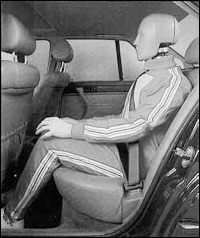Archives
Study finds unbelted passengers become "backseat bullets" during collisions
By LOIS BAKER
Contributing Editor
Drivers, when you fasten your seat belt, make sure the person sitting behind you buckles up, too. It could save your life, as well as your passenger's.

UB research has shown that buckling up in the back seat could save the driver's life, as well as the passenger's.
That's the message from soon-to-be published research conducted by investigators at the Center for Transportation Injury Research (CenTIR), affiliated with UB and the Calspan UB Research Center.
Their analysis of data from nearly 300,000 fatal crashes over seven years, collected by the National Highway Traffic Safety Administration, showed that during a head-on collision, an unbelted passenger seated behind the driver becomes a "backseat bullet," slamming into the driver and significantly increasing both the passenger's and the driver's risk of death.
"The odds of death were almost three times higher for the unbelted passenger and two times higher for the driver under those circumstances," said Dietrich Jehle, associate professor of emergency medicine. Jehle is the Erie County Medical Center site director of the CenTIR.
To further illustrate the dangers of having an unbelted backseat passenger, the investigators conducted crash tests using instrumented dummies at the CenTIR testing complex in Buffalo. The results showed there was a four-fold increase in maximum force to both the head and chest of the driver when the passenger seated directly behind the driver was unbelted.
"It is estimated that if we approached a rear seat-belt usage rate of 95 percent, more than 800 lives would be saved and more than 65,000 injuries prevented in the U.S.," said Jehle. "This would represent savings of approximately $3.8 billion per year in the U.S.
"Less than one-third of states require adults sitting in the backseat to wear seat belts," said Jehle. "We hope our findings will prompt drivers to make sure that all backseat occupants are properly restrained," he said. "If all rear-seat passengers would buckle up, thousands of lives and billions of dollars could be saved."
Additional researchers on the project, from the UB Department of Emergency Medicine and Erie County Medical Center, were James Mayrose, research assistant professor; Gina Piazza, and Alan Blatt, research assistant professor and director of the CenTIR.
This work was supported in part by a grant from the Federal Highway Administration.
